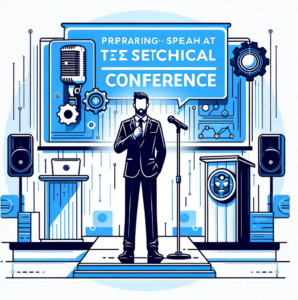 Getting ready to speak at a technical conference can be as nerve-wracking as it is exciting, especially if it’s your first time.
Getting ready to speak at a technical conference can be as nerve-wracking as it is exciting, especially if it’s your first time.
Having had the opportunity to present at notable events like AWS re:Invent, Monitorama, DevOps Days, and GopherCon, I’ve learned a thing or two about preparing for the big stage.
The essence of a good talk, I’ve found, isn’t just in the content but in its ability to offer real value to the audience. Here, I want to share some practical tips and preparation strategies that have helped me deliver talks that work.
Know Your Stuff
First and foremost, speak about what you know. This might seem obvious, but it’s crucial. Your familiarity with the subject not only boosts your confidence but also ensures that you can dive deep into the nuances that your audience will find valuable. It allows you to speak with conviction.
Stick to your expertise and share insights that only experience can teach. But be clear about what you don’t know either, when your talk is veering into speculation, or into an area that you’ve chosen not to specialize in. This adds important credibility to your presentation.
Craft Your Content with Care
Start with a top-down approach to creating your content. Identify the key themes you want to cover and structure your talk around these pillars. This method helps in organizing your thoughts and ensuring that your presentation has a logical flow. Always ask yourself, “What can my audience gain from this?”
 People attend technical conferences to learn and grow – not just to listen to your war stories. Whether it’s a new skill, insights into a complex problem, or lessons learned from failures, make sure your talk delivers tangible value.
People attend technical conferences to learn and grow – not just to listen to your war stories. Whether it’s a new skill, insights into a complex problem, or lessons learned from failures, make sure your talk delivers tangible value.
My AWS re:Invent talk demonstrates this, using a section titled A Few False Starts. Your audience will often learn more about from what you did wrong than what you did right.
Structuring Your Talk
 A time-tested framework for any presentation is to:
A time-tested framework for any presentation is to:
- Tell them what you’re going to tell them
- Tell them
- Then tell them what you told them
This sets expectations, delivers on them, and then reinforces the key takeaways.
You can see this approach in action with my Monitorama presentation. The tell, show, remind framework ensures that your audience leaves with a clear understanding of your message, and is an elegant and natural way to finish your talk.
The Art of Delivery
Rehearsing is non-negotiable.
Practice your talk multiple times, both alone and in front of colleagues. Offer a dry-run presentation at work — teammates will appreciate the chance to learn something new, and it raises your profile!
If possible, try to get access to PA system during one of your rehearsals. It’s one thing to speak in the quiet of your office and another to hear your voice amplified back at you. This practice helps in adjusting to the actual experience of delivering your talk, managing your pacing, and getting comfortable with the sound of your voice filling a room.
![]() If the conference offers a chance to rehearse in the actual hall during the conference, grab it! This was something I could do during GopherCon 2023 and it was a great help.
If the conference offers a chance to rehearse in the actual hall during the conference, grab it! This was something I could do during GopherCon 2023 and it was a great help.
It’s all about familiarizing yourself with the environment. If that’s not possible, at least attend a talk in the same venue to get a feel for the setup and acoustics. Understanding the space can significantly reduce surprises on the day of your talk.
Prepare for Practicalities
Prepare for the unexpected by having backups of your presentation material. Assume network issues will arise and plan accordingly. Also, remember that laser pointers may not translate well to recorded sessions or be visible to online participants.
What not to do
To me there is one big thing not to do — and that’s coding.
While others may disagree, I advise against live coding unless in a small-group, workshop-type setting. Coding presents readability and pacing challenges that can detract from your message.
Focus instead on the principles and architecture underpinning the code, using static code snippets sparingly. You can see that in action with my GopherCon presentation.
Break a Leg
By integrating these strategies into your preparation, you can enhance not just the quality of your presentation but also your connection with the audience.
Remember, the goal is to share knowledge in a way that is engaging, informative, and, ultimately, useful. With the right preparation, you can transform a daunting speaking slot into a career highlight.